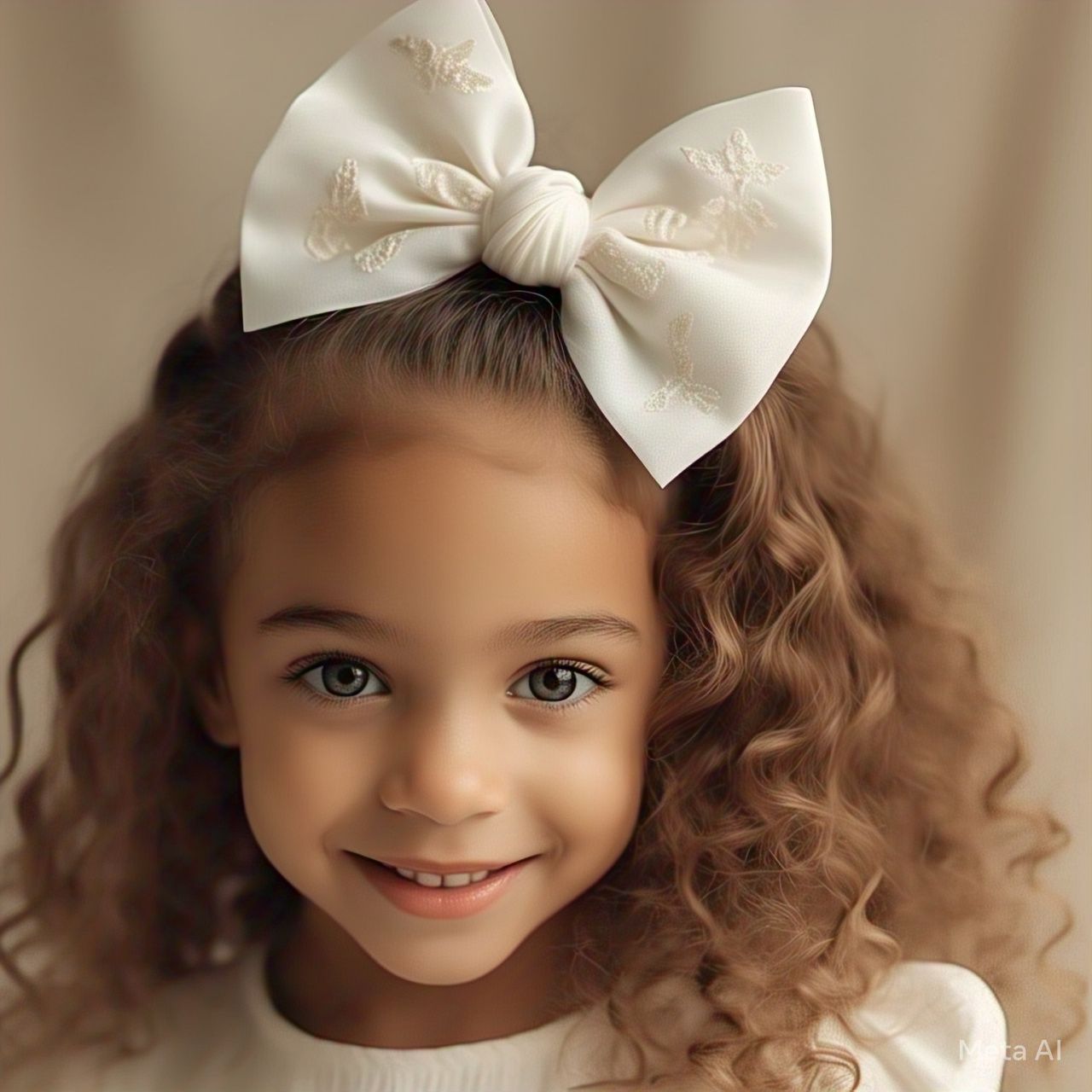The Origins and Evolution of the White Hair Bow
The white hair bow, often perceived as a simple and dainty accessory, holds a deep and fascinating history. While it may seem like an unassuming piece of fashion, its symbolic significance and widespread presence across multiple cultures and generations reveal a far more intricate story. The evolution of the white hair bow spans centuries and connects deeply with various movements, from the aristocracy to modern pop culture, making it an iconic fashion element in the world of accessories.
The Early Beginnings of Hair Accessories
Hair accessories have been around for as long as recorded history, with primitive civilizations using simple materials to adorn their hair. Ancient Egyptians, for example, were known for their elaborate hairstyles, often adorned with beads and ribbons. These early forms of hair adornment signaled social status and wealth. However, it wasn’t until the 17th century that accessories, like ribbons and bows, started becoming more significant in Western fashion.
Throughout history, hair ribbons were used in a variety of ways, ranging from simple functional items to markers of one’s social standing. The white hair bow, in particular, became a popular element during the Rococo period in the 18th century. During this time, both men and women of aristocratic backgrounds embraced extravagant clothing styles, and accessories were used not only as fashion statements but also as representations of wealth and luxury.
The 19th Century and the Shift Toward Femininity
By the time the 19th century arrived, the white hair bow had undergone a transformation, shifting from a symbol of high society to a tool used in the feminine expression of beauty. In Victorian society, women were expected to uphold high standards of modesty and virtue, and the accessories they wore often reflected these values. The white hair bow emerged as a delicate and refined addition to a woman’s attire, symbolizing purity, innocence, and grace.
Victorian women wore their hair in intricate styles, often swept up and held in place with ribbons and bows. The white bow became a staple in the wardrobes of many young girls and women, reinforcing the era’s ideals of feminine elegance. It wasn’t merely an accessory but a reflection of an idealized notion of womanhood, representing softness, beauty, and innocence.
The Rise of the White Hair Bow in the 20th Century
As the 20th century unfolded, the white hair bow began to transcend its aristocratic roots. The early part of the century saw the accessory gain popularity in both Western and Eastern cultures. In the United States, for example, women in the 1920s adopted a more practical and functional approach to fashion, influenced by the flapper movement and the growing emphasis on independence. The white hair bow, while still a symbol of femininity, took on a less formal and more playful tone, making it accessible to women of all social classes.
In the post-World War II era, the white hair bow’s status as an iconic fashion accessory further cemented itself. During the 1950s and 1960s, the rise of television and film brought new visibility to celebrities who wore this accessory, helping it reach even broader audiences. Icons like Audrey Hepburn and Grace Kelly were frequently seen sporting white hair bows in films and public appearances, making the accessory synonymous with elegance and grace. This period marked the white bow’s transition from a mere fashion item to an enduring symbol of refinement.
The White Hair Bow’s Cultural Impact Across Decades
Throughout the 20th century, the white hair bow continued to appear in various forms, from everyday fashion to high couture. Its association with femininity, purity, and elegance remained intact, but its adaptability allowed it to fit seamlessly into a variety of subcultures. From the 1980s and the rise of punk fashion to the 1990s’ grunge era, the white hair bow subtly influenced different styles, proving its versatility.
Even in modern times, the white hair bow remains a potent symbol of elegance, femininity, and charm. Its place in popular culture is undeniable, with the accessory often being worn by celebrities, fashion icons, and even in everyday life by people seeking to make a subtle yet meaningful fashion statement.
The white hair bow’s enduring presence and versatility across different historical periods and cultures highlight its symbolic power. While it may appear to be a simple detail, its cultural and historical significance cannot be overstated. The accessory has evolved from a mere fashion item to an emblem of grace, purity, and timeless beauty.
The Symbolism and Cultural Significance of the White Hair Bow
The white hair bow, though often perceived as a simple fashion accessory, carries with it a deep and nuanced symbolism that has evolved over centuries. Its significance transcends its physical form, as it reflects various cultural ideals, social movements, and personal expressions. In this part, we will delve into the symbolic meanings behind the white hair bow, examining its role in representing purity, innocence, and femininity, as well as its cultural impact on various generations.
Purity and Innocence: The Core Values Behind the White Bow
One of the most enduring symbols associated with the white hair bow is purity. White has long been associated with innocence and cleanliness, and the use of this color in the accessory underscores its connection to these values. Throughout history, the white hair bow has been seen as an expression of youthful innocence, particularly in the context of childhood fashion.
In Western societies, the white bow became a staple in the attire of young girls, often worn with dresses and other garments that embodied the ideals of femininity and virtue. The accessory was frequently used to mark the transition from childhood to adolescence, symbolizing a certain purity of spirit. In this context, the white hair bow was not just a fashion statement, but a representation of a more profound cultural value: the innocence of youth.
In the Victorian era, the ideal of purity and innocence was central to societal expectations for women. Young girls, especially, were often depicted wearing white dresses with matching bows, symbolizing their untarnished character. This image of purity persisted through the early 20th century, especially in children’s fashion, where the white bow became an essential part of a girl’s wardrobe, signifying her connection to an idealized, untainted world.
Femininity and Elegance: The White Hair Bow as a Feminine Icon
As much as the white hair bow represents purity, it is equally intertwined with femininity and grace. Its delicate appearance and gentle color make it a quintessentially feminine accessory, and its association with femininity has been key to its cultural importance.
The bow’s soft, flowing nature embodies the gentleness often associated with idealized femininity. In the early 20th century, women’s fashion began to shift toward a more streamlined and practical style. Yet, even as women’s roles in society evolved, the white bow remained a powerful symbol of feminine elegance. During the 1950s, for instance, the popularity of elegant and sophisticated fashion icons such as Audrey Hepburn and Grace Kelly brought the white bow back into the spotlight. These women, known for their timeless beauty and poise, often accessorized with delicate white bows, cementing their association with elegance.
The white hair bow, in many ways, became a tool for women to express their femininity without needing to rely on extravagant or ostentatious clothing. By incorporating a simple yet striking accessory into their outfits, women were able to convey sophistication and grace, reflecting the cultural norms and ideals of the time. Over the decades, the white bow’s connection to femininity has remained a constant, further solidifying its place in fashion history.
The White Hair Bow in Pop Culture and Media
Beyond its role as a fashion accessory, the white hair bow has permeated popular culture and media, cementing its iconic status. The white bow became synonymous with innocence and femininity, appearing in films, cartoons, and advertisements as a representation of youthful charm and grace. In particular, the white bow’s association with childhood and femininity was reinforced by its presence in the media.
Characters in film and television often wore white bows, reinforcing their status as the embodiment of innocence and charm. For example, in the 1930s and 1940s, actresses such as Shirley Temple popularized the white hair bow as a symbol of the cute and lovable child star. Temple’s signature style, which often featured white bows in her curls, made her an enduring figure in American pop culture, helping to solidify the bow’s place as a symbol of both purity and charm.
In the world of animation, characters like Disney’s Minnie Mouse further ingrained the white bow as an icon of femininity and innocence. Minnie, with her trademark white bow, has become one of the most recognizable figures in the world, and the bow continues to represent the ideal of the sweet, playful, and innocent girl. This association with animated characters, coupled with the emotional resonance that these characters hold for generations of fans, has kept the white bow a prominent symbol of youth and femininity in popular culture.
The White Hair Bow in Modern-Day Fashion
While the white hair bow may have originated in historical contexts, its continued relevance in modern fashion speaks to its adaptability and timeless appeal. Today, the white hair bow can be seen on runways, in street style, and among celebrities, proving that this simple accessory is as iconic now as it has ever been.
In the world of fashion, the white hair bow is often used to evoke nostalgia, bringing a sense of classic elegance and charm to contemporary designs. Designers regularly incorporate bows into their collections, using them in both subtle and bold ways. Whether it’s a small, understated white bow adorning a chic dress or a large, dramatic bow placed prominently in an avant-garde look, the white bow remains a symbol of timeless style.
Celebrities like Taylor Swift, Ariana Grande, and even Kate Middleton have embraced the white hair bow in various public appearances. Swift, in particular, is known for incorporating delicate accessories into her signature style, and the white bow often makes an appearance in her outfits, helping to cement her image as a modern-day style icon. The white hair bow has thus transcended its original cultural contexts, adapting to fit the tastes of contemporary fashion while maintaining its symbolic weight.
The Universal Appeal of the White Hair Bow
The white hair bow’s universal appeal lies in its ability to resonate across different cultures and time periods. While its meaning may vary slightly depending on the context, the overall message remains the same: it is a symbol of elegance, grace, and femininity. Whether worn by young girls, women in the prime of their lives, or fashion-forward celebrities, the white hair bow communicates a sense of timeless beauty and charm.
From its early associations with purity and innocence to its status as a symbol of femininity and elegance, the white hair bow has remained a beloved accessory across generations. Its enduring cultural significance speaks to the power of fashion to communicate deeper values and emotions, and the white hair bow remains an iconic accessory that continues to inspire both nostalgia and admiration.
The White Hair Bow in Fashion Trends and Subcultures
The white hair bow, despite its seemingly simple and delicate appearance, has managed to find its place in diverse fashion trends and subcultures, proving its adaptability and staying power over time. What began as an aristocratic fashion accessory and a symbol of feminine purity has evolved to play a prominent role in different cultural movements, contributing to its status as an iconic fashion element. From high fashion to streetwear and subcultures like goth and punk, the white hair bow has been embraced in unique and innovative ways, showing that this classic accessory has the ability to transcend traditional boundaries.
The White Hair Bow in High Fashion
In the world of high fashion, the white hair bow is often utilized to evoke a sense of refinement and timelessness. Throughout the 20th and 21st centuries, designers have incorporated the accessory into their collections, utilizing its understated elegance to complement sophisticated looks. The delicate nature of the bow offers a contrast to the more structured and bold elements of haute couture fashion, allowing it to be used as a subtle yet powerful accent.
One of the most notable moments for the white hair bow in high fashion occurred during the 1950s and 1960s when designers like Christian Dior and Chanel began using bows in their collections. The elegant designs of Dior, in particular, often featured bows placed strategically in the hair or on dresses, evoking an image of grace and femininity. The bow became a hallmark of the designer’s vision, symbolizing a refined approach to beauty and elegance.
More recently, the white hair bow has made appearances in the collections of designers like Valentino, Oscar de la Renta, and Alexander McQueen. These designers have incorporated bows into their runway shows, using them as statement pieces or as part of more elaborate, theatrical looks. While the white bow is still associated with femininity, its placement and execution have evolved, often juxtaposing the softness of the bow with edgier or more avant-garde elements. This blending of opposites highlights the versatility of the white hair bow as a fashion accessory that can complement both classic and contemporary styles.
Streetwear and the White Hair Bow
The white hair bow has also found a home in streetwear, a fashion movement that embraces casual, urban style. In this context, the white hair bow is often paired with casual outfits such as oversized shirts, graphic tees, and sneakers. Streetwear culture, known for its rebellious and youthful energy, has adopted the white hair bow as a way to add a touch of femininity and charm to an otherwise laid-back look.
Celebrities and influencers have played a key role in the resurgence of the white hair bow in street style. Figures like Rihanna, Bella Hadid, and Kylie Jenner have been seen wearing white hair bows in various casual settings, further elevating the accessory’s status in popular culture. These figures have taken the traditionally sweet and innocent symbol of the white hair bow and made it their own, incorporating it into modern, edgy fashion statements.
What makes the white hair bow so fitting in the context of streetwear is its ability to balance out the rougher, more androgynous elements of the style. While streetwear often emphasizes comfort and utility, the white hair bow softens the look, adding an element of surprise. This contrast between the tough and the tender is a hallmark of street style, and the white hair bow provides an interesting juxtaposition to more utilitarian or street-inspired pieces.
Subcultures and the White Hair Bow: From Goth to Lolita Fashion
The white hair bow’s presence in various subcultures has further cemented its status as a versatile and iconic accessory. One of the most prominent subcultures where the white hair bow has played a significant role is the Lolita fashion scene, which originated in Japan. Lolita fashion is heavily influenced by Victorian and Rococo clothing, characterized by ornate, feminine dresses and accessories. The white hair bow is a key component of this style, symbolizing innocence, modesty, and purity—values that align closely with the Lolita aesthetic.
In Lolita fashion, the white hair bow is often worn alongside frilly dresses, lace stockings, and ribbons, creating a look that is both childlike and sophisticated. The bow, in this context, represents more than just a fashion accessory; it is an integral part of the Lolita style’s emphasis on femininity and grace. The white bow’s association with purity and innocence aligns perfectly with the Lolita fashion ethos, making it a central piece in the wardrobe of those who embrace the subculture.
While the white hair bow is commonly seen in Lolita fashion, it has also made appearances in other alternative subcultures, such as goth and kawaii. In goth fashion, the bow is often used as a contrast to the darker elements of the style, adding a touch of sweetness to the otherwise somber and dramatic aesthetic. The juxtaposition of the white bow with black clothing and makeup creates a striking visual effect, highlighting the contrast between innocence and darkness that is central to goth culture.
In the kawaii subculture, which celebrates cuteness and childlike wonder, the white hair bow is a staple accessory. The playful, whimsical nature of the bow fits perfectly within the kawaii aesthetic, which emphasizes innocence and the celebration of youthful charm. The white bow, in this context, is a symbol of sweetness and purity, aligning with the subculture’s emphasis on all things adorable and endearing.
The White Hair Bow’s Impact on Modern Fashion Movements
In recent years, the white hair bow has experienced a resurgence in popularity, particularly in the context of modern fashion movements that blend nostalgia with contemporary sensibilities. The influence of social media and the rise of platforms like Instagram and TikTok have played a key role in bringing the white hair bow back into the fashion spotlight. Influencers and fashion bloggers regularly share images of themselves wearing the accessory, showing how it can be incorporated into a variety of modern looks.
The white hair bow has also been embraced by the “cottagecore” aesthetic, a trend that romanticizes rural life and traditional, nature-inspired clothing. In cottagecore, the white hair bow serves as a symbol of simplicity and sweetness, often paired with floral dresses and braided hairstyles. The bow complements the soft, ethereal qualities of cottagecore fashion, creating a look that feels both timeless and fresh.
As fashion continues to evolve, the white hair bow remains a symbol of versatility and timeless appeal. Its ability to adapt to different trends, from street style to high fashion to alternative subcultures, ensures that it will continue to hold a place in the ever-changing landscape of fashion.
The Enduring Appeal of the White Hair Bow: Why It Remains a Fashion Icon
The white hair bow, with its delicate simplicity and timeless elegance, has continued to captivate the hearts of fashion enthusiasts, culture connoisseurs, and everyday individuals alike. In the context of fashion history, it stands out as a rare accessory that has maintained its relevance over centuries, evolving to fit the tastes and values of each era while retaining the core qualities that make it iconic. This final part explores why the white hair bow remains a beloved and enduring fashion symbol, highlighting its continued appeal and its ability to adapt to new contexts while keeping its traditional roots intact.
The White Hair Bow’s Resilience Across Generations
One of the key reasons the white hair bow has remained a fashion icon for so long is its remarkable resilience across different generations. Fashion trends come and go, but the white hair bow has always found a way to reintegrate itself into the fashion mainstream, adapting to new styles and trends without losing its original charm. From its early days as a symbol of childhood innocence and purity to its more recent appearances in high fashion, streetwear, and alternative subcultures, the bow has proven to be a truly timeless accessory.
Each generation has found its own way to embrace the white hair bow, interpreting it through the lens of contemporary style while still honoring its traditional meanings. For example, in the 1980s, the white hair bow was popularized by the preppy fashion movement, where it was paired with collared shirts and cardigans, often seen as a nod to youthful sophistication. In the 1990s, the bow made a comeback as part of the “kawaii” (cute) culture in Japan, a subculture that celebrates innocence and femininity.
In recent years, the white hair bow has become a symbol of nostalgia, particularly for millennials and Generation Z, who grew up with the accessory as a part of their childhood wardrobe. With the resurgence of vintage and retro-inspired fashion, the white hair bow has been embraced as a symbol of simpler, more innocent times. Social media platforms like Instagram and TikTok have allowed individuals to share their interpretations of the white hair bow, helping to keep the accessory alive and relevant in the digital age.
A Symbol of Individual Expression
While the white hair bow is often associated with cultural and societal ideals, it also serves as a powerful symbol of individual expression. Whether worn in a simple, understated style or as a bold statement piece, the white bow gives individuals the opportunity to express their personality, mood, or personal aesthetic.
In modern fashion, the white hair bow is no longer strictly a symbol of innocence or femininity. It has evolved to become a versatile accessory that can convey different messages depending on how it is styled and what it is paired with. For example, when worn with a casual outfit, it can evoke a sense of playfulness and youthful energy. When paired with more formal or elegant attire, it can convey grace and sophistication. In alternative subcultures like goth or punk, the white bow can serve as a contrast to darker elements, representing a blend of innocence and rebellion.
The ability of the white hair bow to shift its meaning depending on the context in which it is worn has made it a popular choice for individuals seeking to express their unique style. It is an accessory that allows for both subtlety and boldness, offering limitless possibilities for personal expression. In this way, the white hair bow has become not just a fashion accessory, but a canvas for individual creativity.
The White Hair Bow and Its Role in Social and Cultural Movements
Beyond its status as a fashion statement, the white hair bow has also played a significant role in various social and cultural movements. From its association with childhood purity to its embrace in feminist fashion, the white bow has been used as a symbol to express political and social values.
One such example is the feminist movement of the late 20th and early 21st centuries, where the white hair bow was often used as a symbol of empowerment. By reclaiming traditionally feminine symbols and turning them into expressions of strength and autonomy, women in the feminist movement have used accessories like the white hair bow to challenge the concept of femininity. The white bow, once seen as a passive symbol of innocence, has been reimagined as an active symbol of confidence and independence.
Similarly, in the context of childhood fashion, the white hair bow has continued to be a sign of purity and innocence, but in modern times, it has also come to represent the desire to preserve childhood wonder and imagination. In an increasingly complex and fast-paced world, the white hair bow remains a visual reminder of simpler times, serving as a form of resistance against the pressures of adulthood and the loss of innocence.
A Lasting Icon in Fashion and Beyond
In the end, the enduring appeal of the white hair bow lies in its ability to blend tradition and modernity, innocence and sophistication, and individuality and cultural significance. It is an accessory that has transcended generations and subcultures, remaining relevant in a constantly changing fashion landscape. The white bow is a symbol of femininity, elegance, and purity, but it is also a tool for personal expression and a powerful cultural symbol.
Whether worn by a young girl at a family gathering, a fashion icon on the runway, or an influencer sharing her look on social media, the white hair bow has an unparalleled versatility that allows it to transcend boundaries and remain a lasting fashion statement. Its ability to evoke nostalgia, convey subtle messages, and offer limitless opportunities for personal styling ensures that the white hair bow will continue to be a cherished and iconic accessory for years to come.










